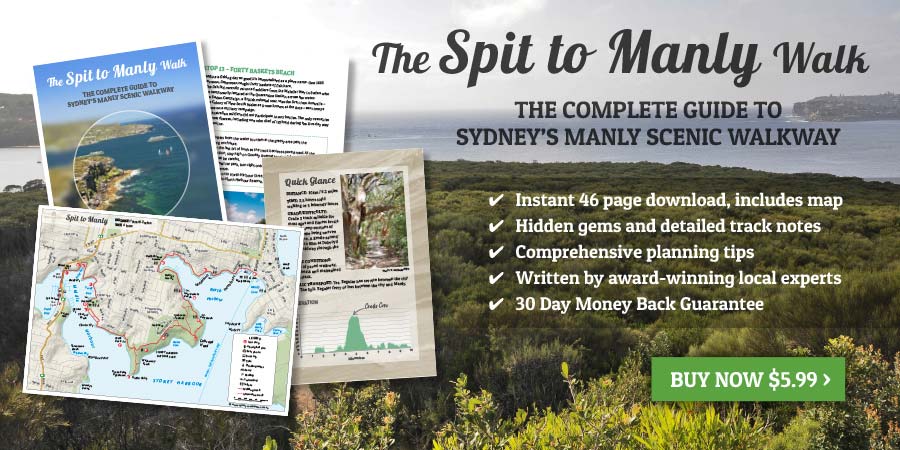The Grotto Point Aboriginal Engravings are Stop 9 on the Spit to Manly Walk, as seen in the downloadable Spit to Manly Complete Guide and Map.
How to get to the Engraving Site
Approaching on foot from the Castle Rock Beach or continuing on from Grotto Point Lighthouse… Continue on the main track towards Manly. Walk up the stone stairs. Soon you’ll see a clearing to the right, marked by a small sign near a heavy-looking railway sleeper. This is the Grotto Point Aboriginal Engraving Site.
Large timber frames are built around each engraving to prevent people from walking on them. Please respect this site by staying outside these frames.
Grotto Point Aboriginal Engraving Site
Sydney is rich with Aboriginal archaeological sites, including middens, cave paintings, axe grinding grooves and the occasional scarred tree.
This site is in a typical rock engraving location: an elevated flat sandstone outcrop.
In this way, the Grotto Point site is similar to a large engraving site at Jibbon in Royal National Park, West Head in Ku-ring-gai Chase National Park, and a much smaller site between Bondi and Tamarama Beach.
People, animals and animal tracks are commonly engraved as well as geometric designs like circles.
The Grotto Point engravings include boomerangs, fish, sharks, a large kangaroo and a fairy penguin.
Aboriginal people follow an oral tradition where knowledge is passed down through storytelling. The engravings on this rock ledge link the Gai-mariagal people to their Creation – timeless Aboriginal mythology and spirituality.
The Grotto Point engraving site is used for educational purposes, such as learning how to source and protect food from the local environment.
The same engravings can have varying meanings and stories depending on the age, gender and level of initiation of the listener.
Due to the engravings’ proximity to the walking track and subsequent high visitation, it is no longer used as a ceremonial site. However, its ceremonial significance is still maintained by descendants of the traditional families.
The engravings are thought to be about 1000 years old and were originally made through connecting a series of holes made by the sharp corner of quartz tools or similar hard rocks.
Engravings were re-grooved in traditional practices, but preservation responsibility now sits with the National Parks and Wildlife Service, in conjunction with the Metropolitan Local Aboriginal Land Council.
Where to go next on the Spit to Manly Walk
Continue up the stairs after exiting the engraving site. Levelling out, the trees subside and you’ll come across a rock ledge with an expanse of harbour and ocean on your right.
This is a view worth stopping for. It is Crater Cove.
Read more about the Spit to Manly Walk.
Get everything about the walk (track notes, stories, map, getting there, and more) by downloading the Spit to Manly Complete Guide (includes map). Or just grab the Spit to Manly Coastal Walk Map.
Jump to any stop by clicking on the name below.
Stop 1: Ellery’s Punt Reserve
Stop 2: Fisher Bay ‘Midden’
Stop 3: Fisher Bay Houseboat
Stop 4: Sandy Bay, Hawkesbury Sandstone
Stop 5: Clontarf Reserve
Stop 6: Clontarf Pumping Station
Stop 7: Castle Rock Beach
Stop 8: Grotto Point Lighthouse
Stop 9: Grotto Point Aboriginal Engraving Site – you are currently on this page
Stop 10: Crater Cove
Stop 11: Dobroyd Head
Stop 12: Reef Beach
Stop 13: Forty Baskets Beach
Stop 14: North Harbour Reserve
Stop 15: Fairlight House
Stop 16: Manly Wharf
Image courtesy of Tony Yeates, Destination NSW. We’ve chosen not to show images of the actual engravings due to sensitivities around publication of sacred images. The image is a DNSW stock image of an engraving site in Ku-ring-gai National Park.




